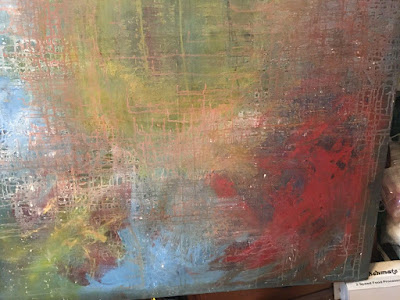by Ernest Hogan
I’m an artist as well as a writer. I started out wanting to be a cartoonist as a kid. People say my writing is very visual, cinematic.
I draw a lot. I’ve even painted. Recently, my mom texted me some pictures she took of one of my paintings. They illustrate this post.
It’s a big one. The biggest I've ever done. It’s not a great painting but has a helluva story behind it.
It was after the great Vietnam/Watergate crash. Gerald Ford was president. America was in deep funk. I was trying to find my way in world that didn’t seem to have a use for me.
I fell into the community college thing. Me and school never got along so good, but I was trying to make the student thing work because people kept telling me that education was the answer to everything. If I tried really hard I could get good grades, and it threw me into depression. I was a sad zombie student.
My art classes helped save my sanity. I got paint and ink all over my clothes, face and hair. Instead of dragging my easel into a corner to hide like everybody else, I would set up in the middle of the studio and make a spectacle of myself.
I was an artist. There was no doubt about that. But what could I do with it?
In a painting class the teacher gave us an assignment of doing a totally abstract painting. The teachers were all staunch modernists, who liked it when your art didn’t look like anything, and thought “storytelling” was a dirty word. I always “got” abstract art, and would even dabble in it as a kid, so I dove in.
The result is the painting in the photos.
First, I threw up a bunch of bright colors, knowing that my teachers didn’t like them. Then I splashed turpentine on the oil paint because they told me that it would just wash it off—note that the canvas still has paint on it.
Then I dribbled paint mixed with turpentine and let it drip. The problem was it always dripped in one direction—down. How monotonous. In my frustration, I turned the canvas on its side, and kept turning it. The problem with that is that ended up creating a vertical/horizontal, architectonic grid.
The problem was the canvas itself. The rectangular shape. Those four corners. And gravity.
I had to come to limits of abstract expression.
If only I could paint in orbit . . . yeah, Jackson Pollock in space! That would be something!
Of course, I couldn’t do that, but I could write about it.
And why not make the artist a Chicano? No one had done that before. Why not test the limits of science fiction while I was at it?
It was another long, hard struggle, but eventually I came up my first published novel, Cortez on Jupiter.
My teachers weren’t that impressed with the painting, which was okay, because I wasn’t very impressed with them, or the fine art world. I don’t “get” these people who buy art, and don’t quite believe that they’re real. To me they’re like UFOs, Bigfoot, or El Chupacabras.
The question is now, what should I do with it? Maybe its connection to the novel will make someone want to buy it . . . My wife suggested we put it in the bigger house we may buy someday.
Maybe I should sign all four corners and scrawl instructions on the back to turn it regularly. Or it could be mounted on slow motor that would turn it . . .
There I go, testing the limits again.
Ernest Hogan, the Father of Chicano Science Fiction is working on novel that he in composing like mural.






No comments:
Post a Comment